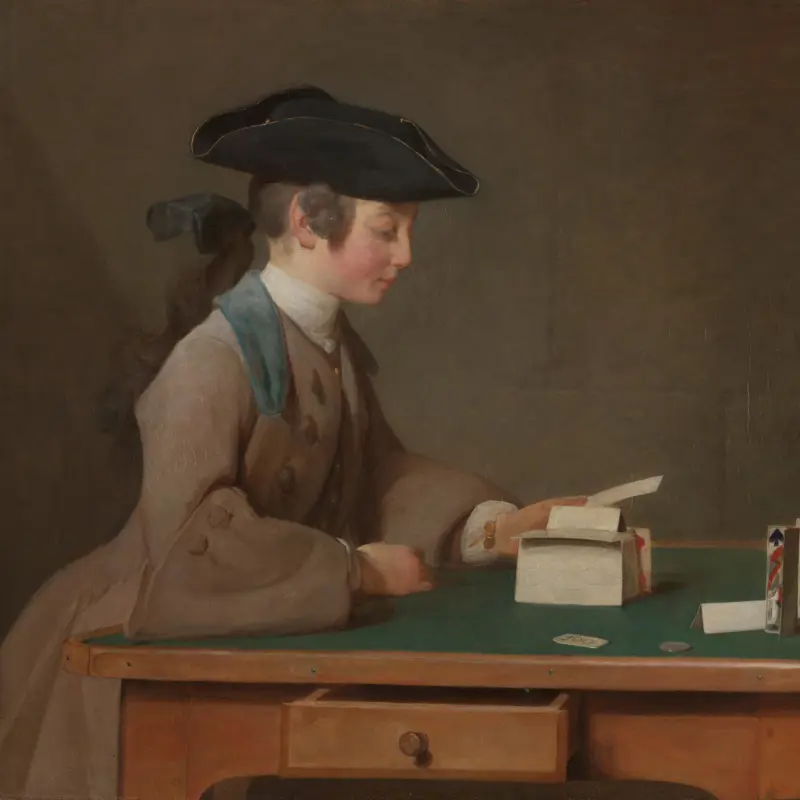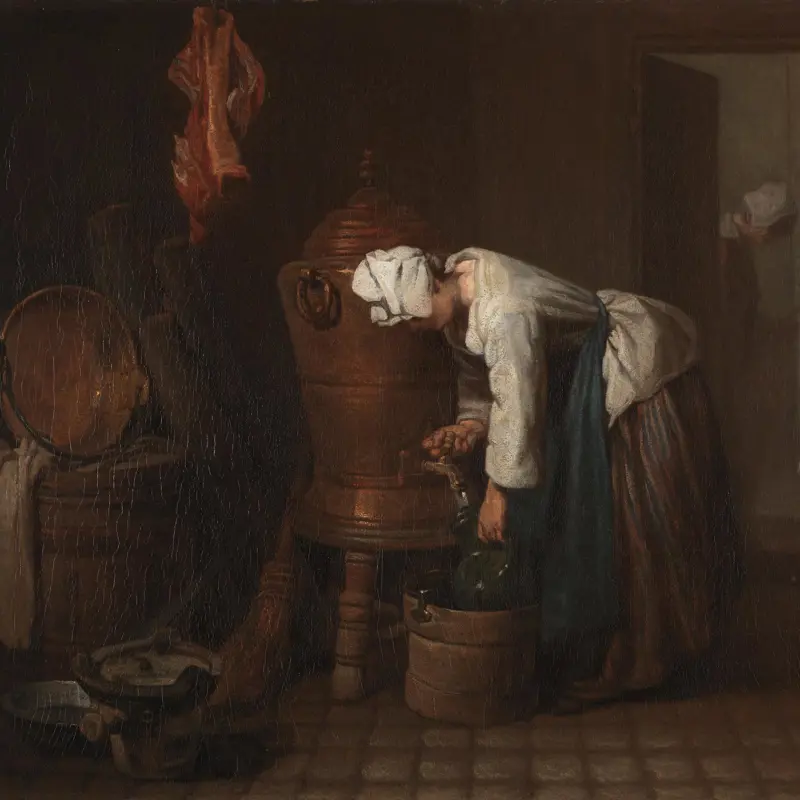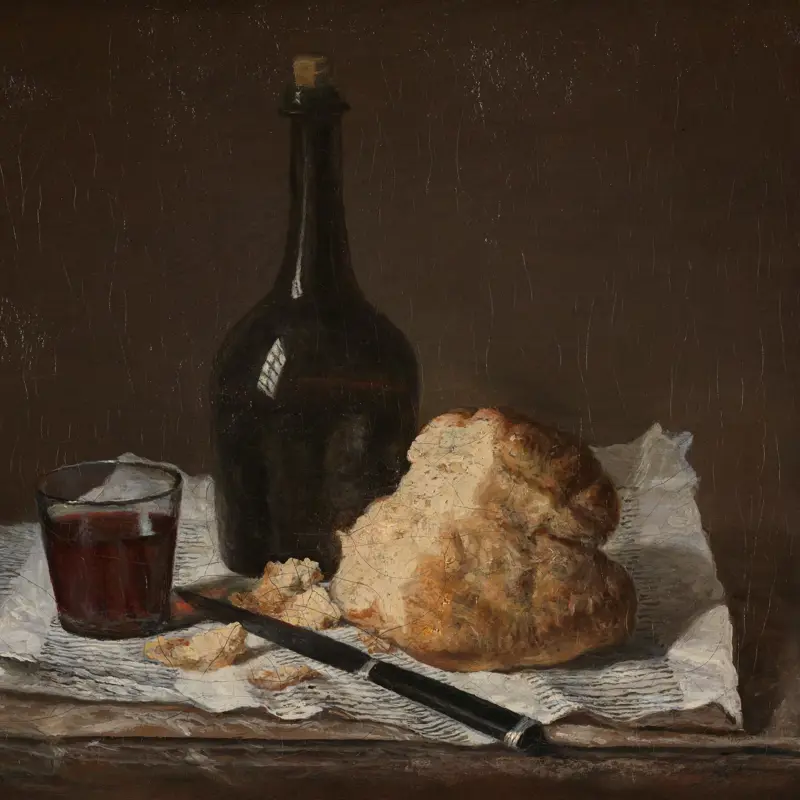Jean-Siméon Chardin, 'The Young Schoolmistress', about 1737
About the work
Overview
A young child is being taught by an older girl, perhaps in her early teens, who is possibly an elder sister or another relation such as a cousin. Despite the picture’s title, this is a private lesson, probably taking place at home rather than at school. The younger child is most likely a boy, although we cannot be entirely sure.
The children appear to be from a middle-class family, which is well provided for but not ostentatiously wealthy. They belong, perhaps, to the growing French bourgeoisie that particularly admired Chardin’s pictures, which they often knew and owned as engravings of the original paintings. This class particularly valued education, especially literacy, which was no longer confined to the nobility and professional classes.
Although Chardin is extolling work and study over playful time-wasting, any moralising purpose to his painting is very understated. Instead, his attention is on a quiet moment of interaction between two individuals.
Key facts
Details
- Full title
- The Young Schoolmistress
- Artist
- Jean-Siméon Chardin
- Artist dates
- 1699 - 1779
- Date made
- about 1737
- Medium and support
- oil on canvas
- Dimensions
- 61.6 × 66.7 cm
- Inscription summary
- Signed
- Acquisition credit
- Bequeathed by Mrs Edith Cragg, as part of the John Webb Bequest, 1925
- Inventory number
- NG4077
- Location
- Room 35
- Collection
- Main Collection
- Frame
- 18th-century French Frame
Provenance
Additional information
Text extracted from the ‘Provenance’ section of the catalogue entry in Humphrey Wine, ‘National Gallery Catalogues: The Eighteenth Century French Paintings’, London 2018; for further information, see the full catalogue entry.
Exhibition history
-
2010Chardin: Il pittore del silenzioMuseo Nacional del Prado1 March 2011 - 29 May 2011
Bibliography
-
1850Christie & Manson, Catalogue of the Exceedingly Choice Cabinet of Dutch and English Pictures and Drawings, Selected With Great Taste by that Well-Known Collector, James Stuart, Esq., Deceased, Late of Boyne Terrace, Notting Hill, London, 18 April 1850 - 19 April 1850
-
1876E. Bocher, 'Jean-Baptiste Siméon Chardin', in E. Bocher, Les gravures françaises du XVIIIe siècle, vol. 3, Paris 1876
-
1925T. Bodkin, 'Chardin in the London and Dublin National Galleries', The Burlington Magazine, XLVII/269, 1925, pp. 93-4
-
1925C. Holmes, 'New Pictures at the National Gallery', The Burlington Magazine, XLVII/268, 1925, pp. 33-5
-
1931A. Pascal and R. Gaucheron, Documents sur la vie et l'oeuvre de Chardin, Paris 1931
-
1933G. Wildenstein, Chardin, Paris 1933
-
1946Martin Davies, National Gallery Catalogues: French School, London 1946
-
1948W. De La Mare, Chardin, 1699-1779, London 1948
-
1950B. Denvir, Chardin, London 1950
-
1954N. Wallis, 'Chardin, the Superlative Craftsman', The Connoisseur, CXXXIII, 1954
-
1957Martin Davies, National Gallery Catalogues: French School, 2nd edn (revised), London 1957
-
1968D. Sutton, France in the Eighteenth Century (exh. cat. Royal Academy of Arts, 6 January - 3 March 1968), London 1968
-
1969G. Wildenstein and D. Wildenstein, Chardin, trans. S. Gilbert, revised edn, Oxford 1969
-
1972D. Chapeaurouge, 'Chardins Kinderbilder und die Emblematik', Actes du XXIIe Congrès International d'Histoire de l'Art, Budapest 1969, II, 1972, pp. 51-6
-
1973E. Snoep-Rietsma, 'Chardin and the Bourgeois Ideals of His Time', Nederlands Kunsthistorisch Jaarboek, XXIV, 1973, pp. 147-243
-
1977H.W. Janson (ed.), Catalogues of the Paris Salon 1673 to 1881, New York 1977
-
1978M. Kemp, 'A Date for Chardin's Lady Taking Tea', The Burlington Magazine, CXX/898, 1978, pp. 22-5
-
1978R. Hamilton, The Artist's Eye: Richard Hamilton (exh. cat. The National Gallery, 5 July - 31 August 1978), London 1978
-
1979P. Rosenberg, Chardin, 1699-1779 (exh. cat. Galeries Nationales du Grand Palais, 29 January- 30 April 1979), Paris 1979
-
1980M. Fried, Absorption and Theatricality: Painting and Beholder in the Age of Diderot, Berkeley 1980
-
1983P. Rosenberg, Tout l'œuvre peint de Chardin, Paris 1983
-
1985P. Conisbee, Chardin, Oxford 1985
-
1987L. Freud, The Artist's Eye: Lucian Freud (exh. cat. The National Gallery, 17 June - 16 August), London 1987
-
1990M.A. Holly, 'Past Looking', Critical Inquiry, XVI/2, 1990, pp. 371-96
-
1994M.R. Michel, Chardin, Paris 1994
-
1995G. Edizel, Jean-Siméon Chardin: Seeing, Playing, Forgetting, and the Practice of Modern Imitation, Ann Arbor 1995
-
1996M.A. Holly, Past Looking: Historical Imagination and the Rhetoric of the Image, Ithaca 1996
-
1999P. Rosenberg and R. Temperini, Chardin: Suivi du catalogue des oeuvres, Paris 1999
-
1999P. Rosenberg and R. Temperini, Chardin, Paris 1999
-
2001
C. Baker and T. Henry, The National Gallery: Complete Illustrated Catalogue, London 2001
-
2001J.D. Herbert, 'A Picture of Chardin's Making', Eighteenth-Century Studies, XXXIV/2, 2001, pp. 251-74
-
2003A. Graham-Dixon, In the Picture: The Year through Art, London 2003
-
2003C.B. Bailey and P. Conisbee, The Age of Watteau, Chardin and Fragonard: Masterpieces of French Genre Painting (exh. cat. National Gallery of Canada, 6 June - 7 September 2003; National Gallery of Art, Washington, 12 October 2003 - 11 January 2004; Staatliche Museen zu Berlin, Gemäldegalerie, 8 February - 9 May 2004), New Haven 2003
-
2004A. Rosenthal, 'Infant Academies and the Childhood of Art: Elisabeth Vigée-Lebrun's Julie with a Mirror', Eighteenth Century Studies, XXXVII/4, 2004, pp. 605-28
-
2005R. Démoris, 'Inside/interiors: Chardin's Images of the Family', Art History, XXVIII/4, 2005, pp. 442-67
-
2009E. Barker, 'Imaging Childhood in Eighteenth-Century France: Greuze's Little Girl with a Dog', Art Bulletin, XCI/4, 2009, pp. 426-45
-
2018Wine, Humphrey, National Gallery Catalogues: The Eighteenth Century French Paintings, London 2018
Frame
This is an eighteenth-century French pastel frame. Crafted in oak and water-gilded, the frame’s back edge has an acanthus-leaf-and-tip motif. There is a central band of carved, chained gadroons along the inwardly curved top edge. This is followed by a wide reverse ogee profile, leading to a narrow, astragal moulding that steps down to a sanded flat. The sight edge is also adorned with acanthus leaves. Réparure tooling was primarily used to embellish the carved background, with punch markings applied at the centre of each chained connection.
During the reign of Louis XV, pastel portraits gained immense popularity in Paris, leading to the creation of a distinctive style of frame specifically designed for works on paper, known as the ‘pastel frame’. These frames were typically linear and featured shallow rebates to securely hold the artwork. Supported by Mr and Mrs Alan Horan in 2006, this pastel frame for The Young Schoolmistress was acquired to complement the reframing of Chardin’s The House of Cards.
About this record
If you know more about this work or have spotted an error, please contact us. Please note that exhibition histories are listed from 2009 onwards. Bibliographies may not be complete; more comprehensive information is available in the National Gallery Library.




